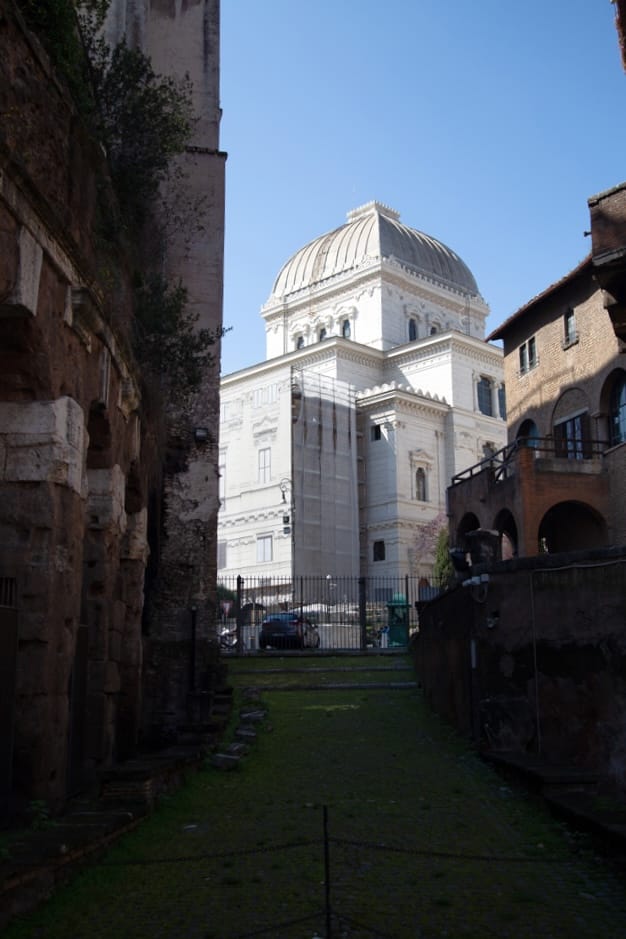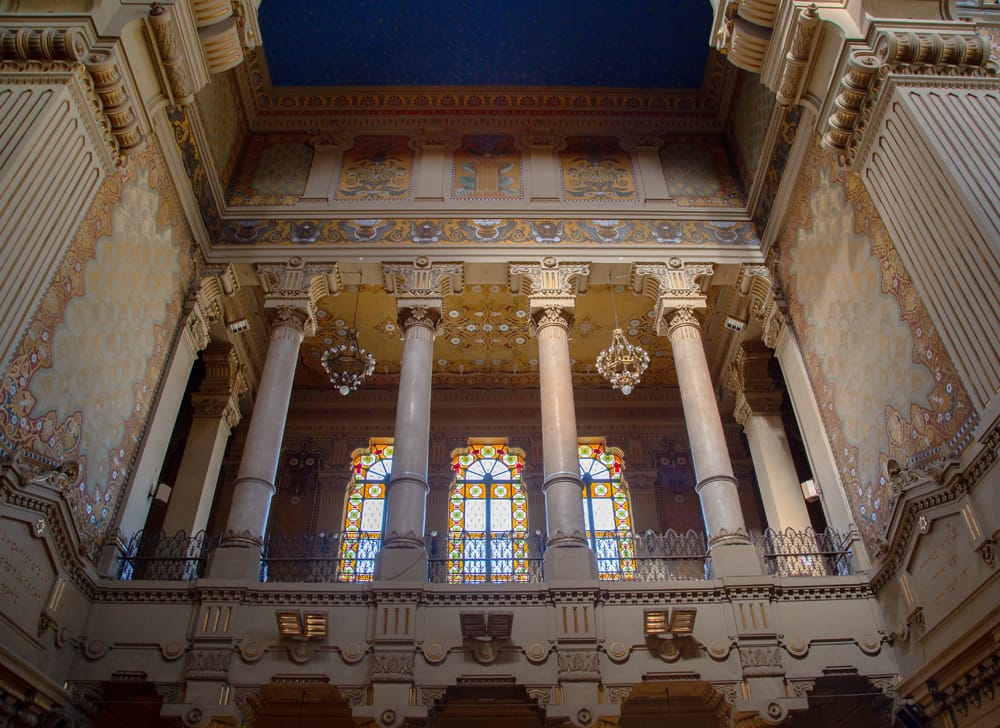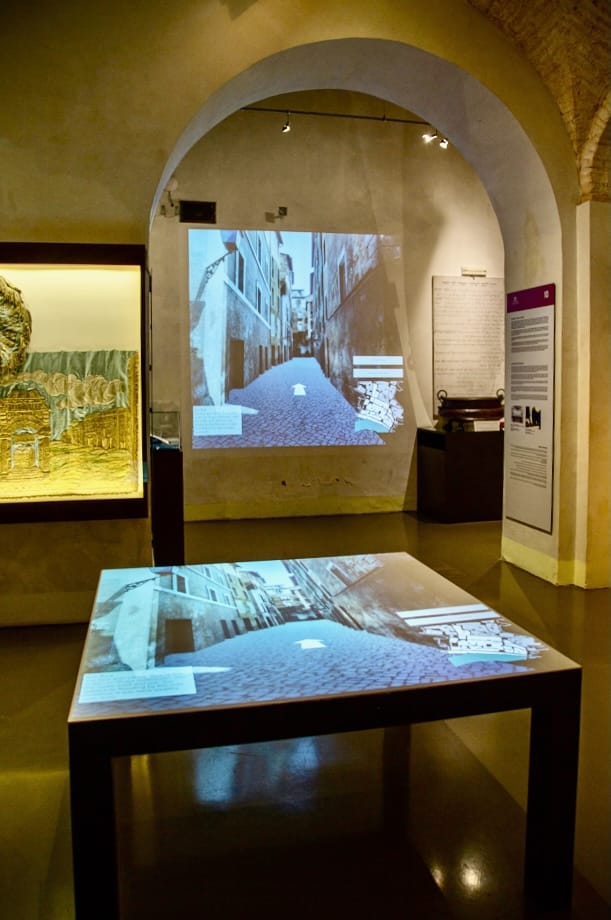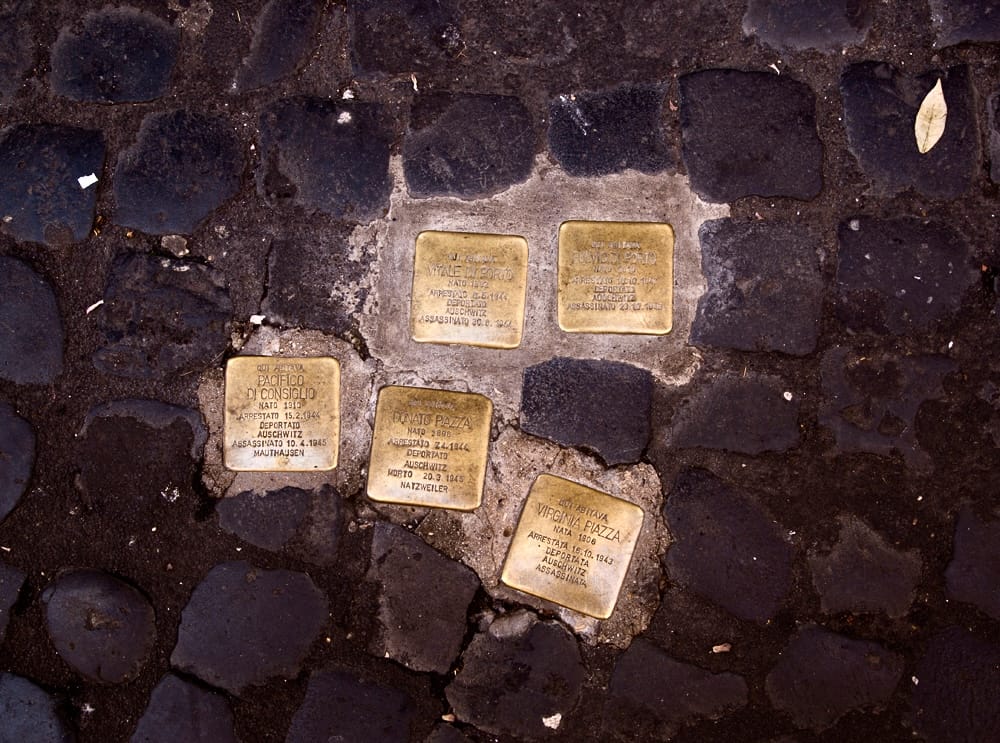Exploring Jewish Rome

by Neala McCarten
photos by Neala McCarten
Last year I was in Israel for the first time, seeing the Israeli flag flying over a building in Tel Aviv was the most inspiring sight the Jewish side of my identity had ever seen…until I walked into the Great Synagogue of Rome, known in Italian as Tempio Maggiore di Roma.
The Jewish community of Rome goes back to the 2nd century BCE when the Roman Republic had an alliance of sorts with Judea and many Jews migrated to Rome. Their role in the Mediterranean trade also stimulated the Roman Jewish population. But Rome dominated the area of Judea and eventually the Jews didn’t take kindly some of the excesses of Roman domination – oppressive taxation and religious disrespect. The political machinations of Rome and infighting among the Jewish factions made things worse. The Jews fought the Romans, and sometimes each other. In 69 CE Vespasian marched on Rome and crowned himself as emperor, leaving his son Titus to besiege Jerusalem in 70 CE, destroying the Second Temple. This was known as the First Jewish–Roman War (66–74 CE). Two more followed—the Bar Kokhba revolt in Judea in 132 CE was the third uprising. It too failed, and with each loss, the Jewish population was further devastated.
But the Jews of Rome managed to persist, even through the Holocaust. Today there are roughly 22 generations of Jewish Romans and it is one of the oldest sites of Jewish culture. The area that was once the ghetto is now a popular area known as Trastevere.

Tempio Maggiore di Roma
This breath-taking building was constructed between 1901 to 1904 on land that had been the former Jewish quarter. The unique architecture was chosen by the community to be a visible celebration of their freedom from the ghetto life.
Its two designers, Vincenzo Costa and Osvaldo Armani, created a bold design best described as eclectic, with Egyptian, and Greco-Roman elements creating a sense of grandeur. The interior of the synagogue created by Domenico Bruschi and Annibale Brugnoli is stunning, lavishly decorated and colorful. One of my favorite touches was the ceiling decorated with stars reminding us that we may someday be as numerous as the stars in the heavens.
The dome that tops the synagogue is the only square dome in the city and makes the building easily identifiable, even from a distance. The synagogue is still in use today with its Orthodox congregation holding regular services.


Museo Ebraico di Roma https://museoebraico.roma.it/en/
The survival of Roman Jews and their way of life is part of the story told in the Jewish Museum in the synagogue’s lower level, reached through a separate entrance. The museum covers Jewish history, Roman Jewish history (including the ghetto period of 1555-1870), and the complexity of Jewish religious life.

The museum also incorporates much of the smaller Spanish synagogue that had been part of the original ghetto. The 1492 Spanish Inquisition forced many Jews to leave Spain (and Spanish area of lower Italy). These refugees created an influx of into Rome where they started their own synagogue.
An interactive map encourages visitors to virtually explore the former ghetto. There is also an interesting explanation of the Roman Jewish dialect. We know about Yiddish and Ladino, but Roman Jews also created a unique Judeo Roman fusion.
The Libyan Judaism Hall is dedicated to the immigration of 4,000 Libyan Jews who passed through Italy. Two thousand of them continued their journey to Israel, while the rest settled permanently in Rome.
La Fondazione Museo della Shoah (the Holocaust Museum) https://www.museodellashoah.it/
As I walked out of the synagogue I noticed a sign across the street, announcing La Fondazione Museo della Shoah. Italy has joined with many other countries in Holocaust education, presented with its own perspective.
The Casina dei Vallati, a 13th century building with 16th century updates, is now home to the Museo della Shoah Foundation. Its free museum focuses on the deportation of nearly 2,000 Italian Jews in 1944 to concentration camps including Belzec, Sobibor, and Treblinka. There’s also a section on Jewish defiance. Too often Jews are depicted as people who just quietly died. It is important to be reminded that resistance was mounted.

Stolpersteine -- Stumbling Stones https://www.stolpersteine.eu/en/home
As there is throughout many countries once occupied by Nazis, Rome has "Stolpersteine" (stumbling stones). This started as a European art project by Gunter Demnig, who created an individual memorial for each victim. These small brass plaques are set into the pavement in front of houses of the (mostly Jewish) residents murdered by the Nazis. The name, date of birth, date and place of death, mostly in a concentration camp, are etched in these memorial “stones”. Demnig cites the Talmud as the reason for the project: "A human being is forgotten only when his or her name is forgotten."

Arch of Titus
One last place is worth a visit. The Arch of Titus is located in the heart of Rome, just a short walk from the Colosseum. Titus is remembered by Jews as the man who destroyed the Second Temple in 70 CE. A highpoint, for the Romans, was the triumphant parade displaying the holy vessels from the Temple. Legend has it that Jews once refused to walk under the arch. Today, however, the Arch of Titus could also be viewed a symbol of the resilience of the Jewish people. I still wouldn’t walk under it.
Neala McCarten is a freelance travel writer and former publisher of the website Offbeat Travel. She writes about where she lives. Having moved from Albuquerque to Florida, her latest book is Offbeat Florida: The nature, history, culture, and quirk of the Sunshine State. Top-ranked among Florida travel guides, it is available on Amazon at: https://www.amazon.com/dp/B0CHL94SXM/
To see more articles click here, or the HOME button at the top.
Return to HOME or Table of Contents
Community Supporter Advertisers of the NM Jewish Journal:
Jewish Community Foundation of New Mexico
Congregation Albert
Temple Beth Shalom
Jewish Community Center of Greater Albuquerque
The Institute for Tolerance Studies
Shabbat with Friends: Recapturing Together the Joy of Shabbat
Jewish Federation of El Paso and Las Cruces
Congregation B'nai Israel
Event Announcement Advertisements
New Mexico Jewish Historical Society FALL CONFERENCE
Jewish High Holiday Gathering to Remember
Copyright © 2024-2025 New Mexico Jewish Journal LLC. All rights reserved.
Policy Statement Acceptance of advertisements does not constitute an endorsement of the advertisers’ products, services or opinions. Likewise, while an advertiser or community supporter's ad may indicate their support for the publication's mission, that does not constitute their endorsement of the publication's content.
Copyright © 2024-2025 New Mexico Jewish Journal LLC. All rights reserved.



